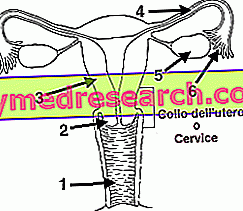What is cervical mucus?
Cervical mucus is a stringy and viscous substance, more or less dense, which performs several important functions:
- lubricates the cervix (or cervix)
- protects the most internal organs of the genital sphere from infections, such as the body of the uterus and the fallopian tubes: the cervical mucus has bacteriostatic properties
- opposes the passage of spermatozoa in the phases in which the woman's organism is not predisposed to fertilization
- facilitates the passage, survival and capacitation process (through which they acquire fertilizing capacity) of spermatozoa during the ovulatory phase, a period in which female fertility is maximum; also in this phase the cervical mucus contributes to trapping between its meshes the less vital spermatozoa, not completely mature or with unfavorable morphological characteristics
- during pregnancy, the cervical mucus becomes particularly dense and accumulates in the cervical canal, obstructing it and creating a protective barrier for the fetus called the mucous plug. This cap is lost shortly before delivery.
All these functions of cervical mucus, in some respects opposed, depend on the woman's endocrine balance, or on her hormonal levels. In particular:
- Estrogens, whose peak occurs near ovulation, stimulate the cervical cells to secrete a viscous, transparent and acellular mucus, which favors the survival and migration of spermatozoa. In addition to becoming more lax, clear and abundant, similar to egg white, in the ovulatory phase the cervical mucus becomes more alkaline, in order to neutralize the typical acidity of the vaginal canal and increase sperm survival.
- The lack of estrogens and progesterone, whose peak occurs after ovulation, stimulate the secretion of a denser and more acidic cervical mucus, which opposes the passage of spermatozoa → a sort of cap is created that blocks the external uterine orifice, through which the cervix opens into the vagina, leaning out in a similar way to a tench snout
Anatomy of the female genital apparatus

1) VAGINA
2) NECK OF THE UTERUS (or Cervix)
3) UTERO
4) FALLOPPIO TUBE
5) OVAIO
6) FIMBRIE

Cervical mucus is essentially the product of the secretion of endocervical cells, to which are added small quantities of fluids coming from the endometrium, the tubes and, probably, from the broken follicle.
Components of cervical mucus
- water: main constituent, it alone represents 90% of cervical mucus → increases in percentage terms in the preovulatory phase (up to 95-98%) and decreases in the other phases of the cycle → this change plays an important role in some contraceptive methods based on observation of cervical mucus
- glucose and other organic components such as glycerol, whose concentration increases during sexual excitement and which probably facilitates fertilization → also the availability of glucose increases the vitality of the spermatozoa, with limited energy reserves
- amino acids and soluble proteins
- electrolytes (calcium, sodium and potassium, zinc, copper, iron, manganese and selenium) → increase in the days immediately before and after ovulation
- the mucus may contain specific antibodies, capable of immobilizing and neutralizing the partner's spermatozoa → immunological incompatibility → the couple's difficulty in having children
- the amount of cervical mucus produced at the beginning of the menstrual cycle was quantified in 20 mcg / day, while in full ovulation this quantity can go up to 600-700 mcg / day; the phenomenon is however subject to a wide individual variability.
Pathological changes
- yellowish and creamy leaks (probable cause: gonoccocic infection);
- greenish-yellow frothy vaginal discharge associated with itching and irritation (probable cause: Trichomonas );
- white, greyish, frothy leaks, of fetid odor especially after sexual intercourse or intimate hygiene (probable causes: bacterial vaginosis, Gardnerella vaginalis );
- modest vaginal discharge well adherent to the walls, associated with intense, white and caseous consistency itching and burning, similar to a "soft cheese" (probable cause: Candidiasis );
- mucus purulent vaginal discharge, associated with pain during sexual intercourse (probable cause: Clamydia , Ureaplasma urealyticum ).
Read the in-depth analysis on the causes of alteration of the cervical mucus
Medications and treatments that alter the cervical mucus
- the contraceptive pills - besides preventing ovulation - increase the density and acidity of the cervical mucus, hindering the passage of the spermatozoa
- estrogens (estradiol acetate, cypionate or valerate) administered alone in the absence of progestins increase the "fertility" of the cervical mucus; they are often associated with clomiphene, a powerful ovulation-inducing drug
Contraception
By observing the changes of the cervical mucus during the menstrual cycle it is possible to obtain indications on which are the fertile days of the woman (days in which she has the possibility of becoming pregnant). This allows you to plan sexual relationships in order to reduce or increase - depending on the case - the chances of a pregnancy.
For this reason, the observation of cervical mucus is one of the strategies adopted by different methods of natural contraception, such as the Billings method and the thermo-thermal method.
Cervical mucus observation

We have seen how in the ovulatory period - which coincides with the moment of maximum fertility of the woman (fertile window) - the cervical mucus becomes more clear, stringy and abundant. These characteristics can be appreciated with the naked eye, but also with the help of laboratory techniques.
In addition to being particularly elastic and stringy, the cervical mucus secreted during ovulation, if left to dry on the slide and observed under a microscope, has a characteristic fern leaf arborization; this peculiarity is known as ferning .
The term " spinnbarkeitt " or filanza is instead referred to the elasticity of the mucus: if it is placed between two slides and moves away, it forms filaments up to 8-12 centimeters long.
By observing the changes of the cervical mucus during the menstrual cycle it is possible to obtain indications on which are the woman's fertile days
Billings method
Natural contraceptive method based on the recognition of ovulation by carefully observing and studying the characteristics of cervical mucus. When the mucus is particularly filamentous, transparent and abundant, causing a "wet" sensation, in all probability the woman is in an ovulatory phase. Therefore, when the woman recognizes this particular signal sent by the body, the couple should refrain from the relationship to avoid an unwanted pregnancy, at least until the third day after the peak of mucous secretion.
Deepening on cervical mucus and Billings method
Syntothermal contraceptive method
It is based on the joint evaluation of cervical mucus and basal temperature: the woman should abstain from the relationship three days before and three days after the maximum peak in body temperature, during which the cervical mucus is particularly stringy and dense.
Deepening on cervical mucus and the thermo-thermal method



